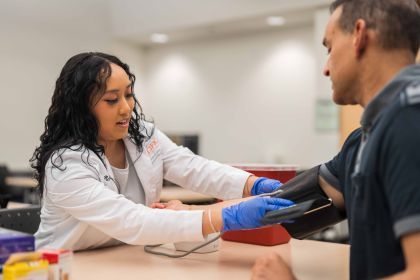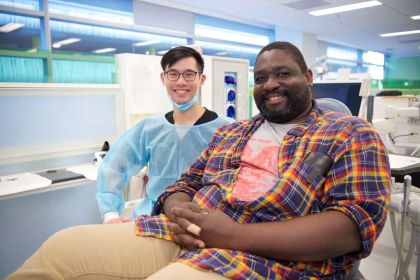Breadcrumb
Dugoni graduate, father go “old school” to help health care workers
Laser cutters and 3D printers are the instruments of choice for legions of volunteers making personal protective equipment (PPE) for health care workers during the coronavirus (COVID-19) pandemic.
Felicia Ortiz ’18, a dental hygiene graduate, went a different route. She headed to Home Depot.
Ortiz and her father, Mike Ortiz, loaded up with head straps, window seal, foam padding, extra-strength tape and even hair ties.
“Yes, hair ties. That’s what we use,” laughed the Tracy native, who still lives in the city and works for two dental practices.
Additional online shopping procured plastic for face shields and other necessities. Then, inspired by two Texas doctors who posted a video about making PPEs out of everyday items, Ortiz and her father set up shop on the living room floor and started making shields.
“We went through a couple of prototypes before settling on something we were comfortable with,” she said. “Each time we start to work on the face shields it gives us a very strong feeling that we are helping people. We want to help them feel safe.”
Felicia and Mike, a splicing technician for AT&T, have made 135 face shields and have a goal of 400. They have sent shields to medical offices, hospitals and even the Safeway grocery chain. “We were pleased to be able to help grocery workers stay safe,” she said.
Ortiz graduated from University of the Pacific’s accelerated, 18-month dental hygiene program at the Arthur A. School of Dentistry — the only school to which she applied.
“UOP and Dugoni had been my dream for as long as I could remember,” she said. “I still remember the day I was accepted into the program. We had a small class of 20, but we felt proud to be part of a great school.”
Ortiz has joined with the Print To Protect Coalition, a PPE community cooperative led by Manteca dentist and Dugoni graduate Dr. Nabeel Cajee ’11, ’15.
“Felicia and her father Mike are remarkable people,” Cajee said. “They are leading the traditional manufacturing component of Print To Protect.”
However, they are branching out from being 100 percent traditional.
“My father and I just bought a 3D printer,” Ortiz said. “We want to be able to help out even more. We now can make the shields a couple of different ways.”





